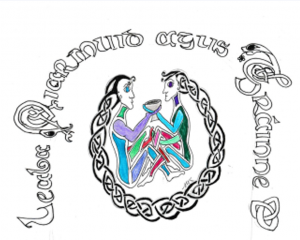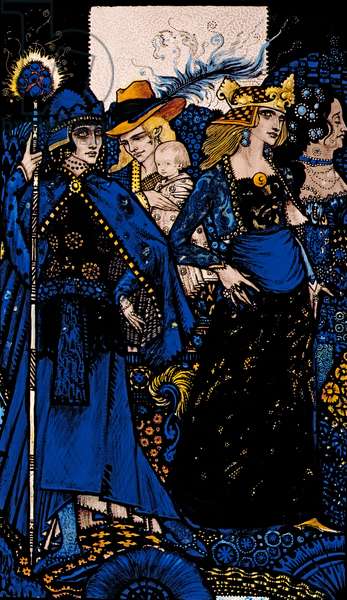by Hilary Kiely
Tóruigheacht Dhiarmada agus Ghráinne: Landscape, Literature, and Cultural Heritage
The Pursuit of Diarmuid and Gráinne (Tóruigheacht Dhiarmada agus Ghráinne) is an epic romance that almost literally swept the nation. Believed to be the basis of the Arthurian story of Tristan and Iseult, it relates the tale of two star crossed lovers chased by a rejected suitor. The suitor in this case being none other than Fionn mac Cumhaill (Finn mac Cool). Like the film “The Princess Bride”, it has “fencing, fighting, torture, revenge, giants, monsters, chases, escapes, true love, (and) miracles.” Dating from earlier than the tenth century, the story has left its mark on Ireland over the centuries.

The earliest surviving version is from the sixteenth century, but it was included in a list of tales in a 10th century manuscript, and an allusion in the Book of Aicill, a law tract of the ninth century, shows that already at that time the tale was distinctly traditional (1)
The beginning
Gráinne is the daughter of the High King Cormac Mac Airt. Fionn Mac Cumhaill, the legendary chief of the fierce warrior band, the Fianna, is looking for a new wife and asks Cormac for his daughter. Cormac asks his daughter what she thinks of the proposal, and she tells her father: if he’s good enough to be your son-in-law, he’s good enough for me. She knows he is a famous and powerful warrior but has not met him.
When the chieftain arrives for the wedding preparations, Gráinne is dismayed to see how old Fionn is. She later sees among his retinue a handsome warrior, Diarmuid O’Duibhne. In some of the many versions of the tale, she sets her sights on Diarmuid mostly because she is just looking for someone willing to run away with her. In others, she chooses Diarmuid because of a “beauty spot” on his face that causes all women to fall in love with him. Whatever her mix of motivations, on the night before the wedding, she puts sleeping potion in the drink of all but Diarmuid. Loyal to his leader, he at first refuses her suggestion that they run away together, so she puts him under a geas (an unbreakable taboo that must be honoured) that he must take her away from there.
The pursuit
They do not get much of a head start, and soon the Fianna are in hot pursuit. The pair encounter gods and monsters who both help and hinder them, Diarmuid must slay a giant of the De Dannan, and fight or outwit entire shiploads of warriors . Some of Fionn’s warriors and allies take his part and other take Diarmuid’s. Along their way, Diarmuid receives this warning from his foster father, Aengus Mac Og:
“Go not into a tree having only one trunk; nor enter a cave with but one opening; never land on an island that has only one channel of approach; where you cook your food do not stay to eat it; where you eat do not sleep; and where you sleep tonight, sleep not there tomorrow night” (2).
In following this advice, the couple made many stops in their efforts to evade the Fianna.
Diarmuid and Gráinne slept here
All along the western half of the island are dozens of places named for spots where the two are believed to have sheltered as they fled from the Fianna. Many of the Neolithic portal and wedge tombs found west of Tara are called after the Iron Age pair. These tombs have stone sides, whether its many stones forming walls or simple uprights, supporting a capstone. Names such as Leabha (Irish for bed) Dhiarmada agus Ghráinne, Labby Rock Gráinne’s/Grainia’s Bed are scattered from Kerry to Donegal. Local tales spoke of how the two built the structures, such as this from near Gort in County Galway:
“Near Lynchs cross at Ballyturn is a field belonging to William Casey. In the middle of that field there are two big stones standing side by side and one over head. There is a big ash tree growing beside it, and the old people said that it was Diarmuid and Gráinne took them there. They got the stone in Chevy Chase. Diarmuid took two in his hands one in each and Gráinne took one on her head. They went down to Ballyturn and they left them there. Diarmuid stuck his own two in the ground, and Gráinne put her stone over them. This is called Leabaidh “Diarmuda and Gráinne.” (3)”

Among other place names, you can also find Diarmuid and Gráinne’s Rock, the sea stack at Loophead in County Clare, and Diarmuid and Gráinne’s cave in the Gleniff Horseshoe in County Sligo.

Fionn’s Foresight
Different versions of the story have them on the run for different lengths of time and Some folktale versions of the telling incorporate Fionn’s “wisdom tooth”, where he can gain insight by biting down on the thumb he burned on the salmon of knowledge. In this way, he would identify where to look for them. Cleverly, the pair would bring heather from the hillsides down to the shore to make their bed, and sand from the beach to the hilltop. In this way, Fionn would see them sleeping in places unlike where they actually were and so they evaded his pursuit. At least one tale told in Leitrim attests to sea sand still laying atop Thur Mountain. (4)
Eventually, Fionn does catch up with them at Benbulben in Sligo. A prophecy has foretold that Diarmuid will be slain by a wild boar and Fionn puts him in a position where he must hunt one. Diarmuid is fatally injured, but by virtue of his encounter with the salmon, Fionn could actually save him if he would give him a drink of water from his hands. Urged on by his son and other warriors of his band, three times Fionn goes to a stream for water but lets it dribble away before he reaches Diarmuid. By the third trip it is too late.
Some tellings have Gráinne reconcile with Fionn and marry him. Others that she has many sons by Diarmuid who help her seek revenge for Diarmuid’s death. Whether anyone had, or even could have had, a happy-ever-after out of this story is not a question that can be answered here. What can be said is that the pursuit of these young lovers across the island left an impression that echoes across the landscape to this day.
If you are interested in reading more about this story, here is a good resource from the Royal Irish Academy :
TÓRUIGHEACHT DHIARMADA AGUS GHRÁINNE: The Pursuit of Diarmaid and Gráinne
Edited by Nessa Ní Shéaghdha (first published 1967)
xxxii + 148 pp. ISBN 1 870 16648 5
|
and
Kevin Murray (ed.), Tóruigheacht Dhiarmada agus Ghráinne: Reassessments (192pp. ISBN: 978-1-9998047-3-2)
|
(1) Krapple, Alexander Haggerty, “Diarmuid and Gráinne” in Folklore , Dec., 1936, Vol. 47, No. 4 (Dec., 1936), pp. 347-361
(2) Carbery, Ethna, In the Celtic Past, 1904 https://www.libraryireland.com/celtic-past/
(3) National Folklore Collection, The Schools’ Collection, Volume 0050, Page 0140
(4) National Folklore Collection, The Schools’ Collection, Volume 0197, Page 458



